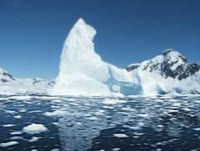Degrees of Change - Climate Change Impacts in Canada in the 21st Century
 Degrees of Change
Degrees of Changeprovides a very clear indication of the possible physical impacts Canadians can expect as a result of climate change.
Earlier this month the National
Roundtable on Economy and Environment and the Royal Canadian
Geographical Society released the
target=”_blank”>Degrees of Change
diagram which lays out potential effects of a changing climate on
Canada at different degrees of warming.
class=”text12pxblue”>The impacts - 60 in all, culled from
documented scientific literature - are categorized into eight
separate sectors and include; ecosystems, water resources, human
health, communities and infrastructure, resource industries,
service industries, security and trade and ice, snow and
sea.
class=”text12pxblue”>The diagram is included in the October
issue of Canadian
Geographic and
Géographica magazines,
which are almost wholly-devoted to climate change. This release
included a special roundtable discussion at the Museum of Nature,
and a launch reception with the Governor General providing the
keynote address.
The
Degrees of Change Diagram
(target=”_blank”>click to download - PDF version)
class=”text12pxblue”>
target=”_blank”>

class=”text12pxblue”>The goal of this project is to widen the
national conversation on the issue of climate change,
the physical effects of which on Canada in the next
century could touch everything from human health and community
infrastructure to water resources and even tourism and recreation
activities.
class=”text12pxblue box”>Compared to average
temperatures prior to the industrial revolution well over a century
ago, the world is currently 0.78°C warmer. What does this mean for
Canada and the people living here now? And what could further
climate change induced temperature increases
entail?
class=”text12pxblue”>“Climate change is not just a theory.
It’s taking place now,” said NRTEE Chair Robert (Bob) Page. “That
means we must go beyond cutting carbon emissions. We must start
adapting our behaviour, our communities, and our economic activity
to the emerging reality of climate change.”
class=”text12pxblue”>At two-degrees warming, for example, the
diagram shows that summer Arctic sea ice extent could be halved,
runoff in the South Saskatchewan River basin significantly reduced,
and shipping through the Great Lakes and St. Lawrence Seaway could
become more costly due to lowering water levels.
class=”text12pxblue”>The two-degree marker represents
temperature increases over pre-industrial levels and is significant
because Canada and other G8 nations have agreed to take measures to
limit global temperature increases to no more than that
level.
class=”text12pxblue”>The diagram and feature articles in the
magazine go on to show even more risks to Canada’s coastal
communities, fish and wildlife habitat, and human health, if global
temperatures rise beyond the two-degree point.
Not all
impacts compiled in the diagram are necessarily negative. For
example, a two-degree increase could see timber gains from enhanced
tree growth in some northerly locations, greater access to northern
oil, gas and mineral resources, and an increased abundance of
Atlantic cod north of the 60th parallel.
Some
tourism and recreational pursuits, such as skiing, would likely be
hurt while others, such as golf, could benefit. The diagram is
meant to illustrate a range of possible impacts that are
scientifically-accepted and projected at this time.
Besides the magazines and poster diagram, the
RCGS and NRTEE will sponsor expert panel discussions and have
collaborated with the RCGS’ Canadian Council for Geographic
Education to produce an education resource package to be
distributed to 12,000 middle and secondary schools across Canada
highlighting the implications of regional and local impacts of
climate change.
The RCGS
Canadian Atlas Online (CAOL) will also carry a dedicated module on
Climate Prosperity with interactive maps, diagrams and 13 lesson
plans in the CAOL Learning Centre.
Dealing with the impacts of
climate change means educating our children, said RCGS President
Gisèle Jacob.“The joint Climate
Prosperity initiative with the NRTEE reinforces the Royal Canadian
Geographical Society’s educational role in fostering environmental
stewardship in Canada” said Ms. Jacob. “Education is
key to widening public understanding of our changing climate, the
impacts and adaptive
solutions.”
“Adapt and
prosper will be increasingly central to Canadian governments,
communities, and businesses as these effects become more and more
evident,” said NRTEE President and CEO David McLaughlin.
The
Diagram and its interactive supporting materials are available
target=”_blank”>here.
Source: www.climateprosperity.ca

